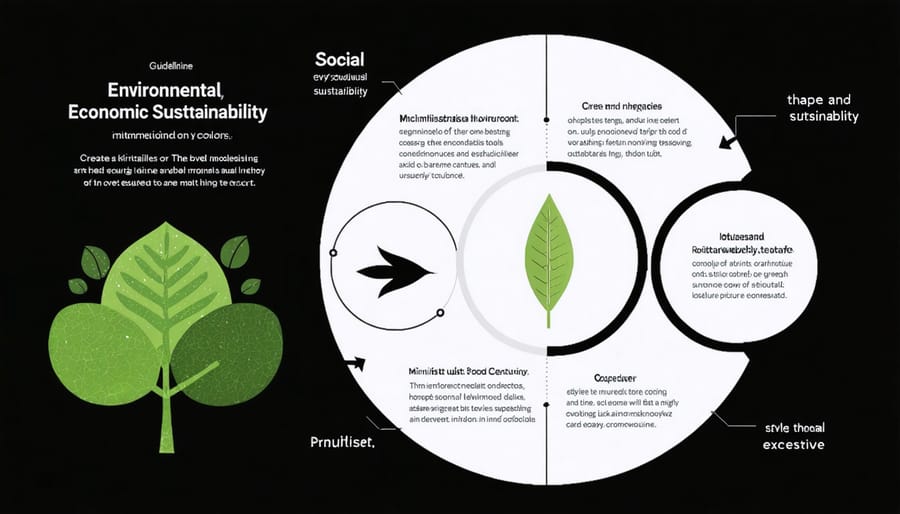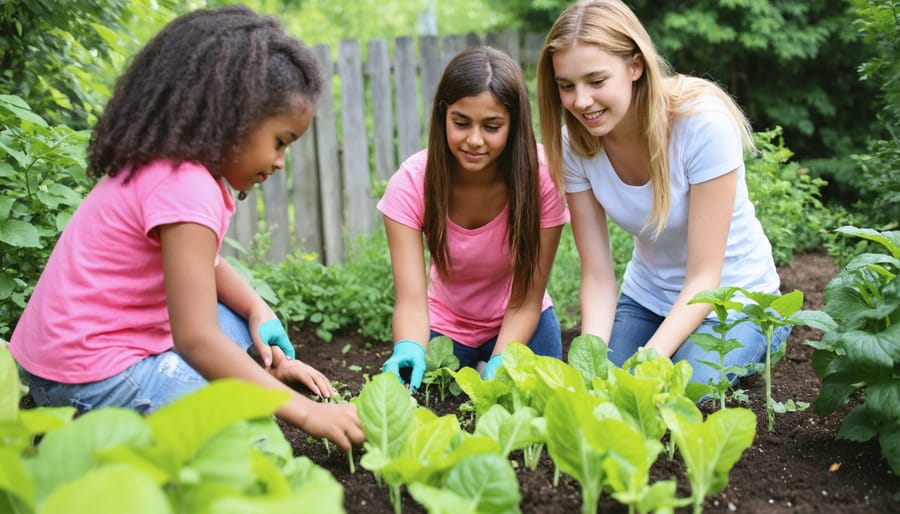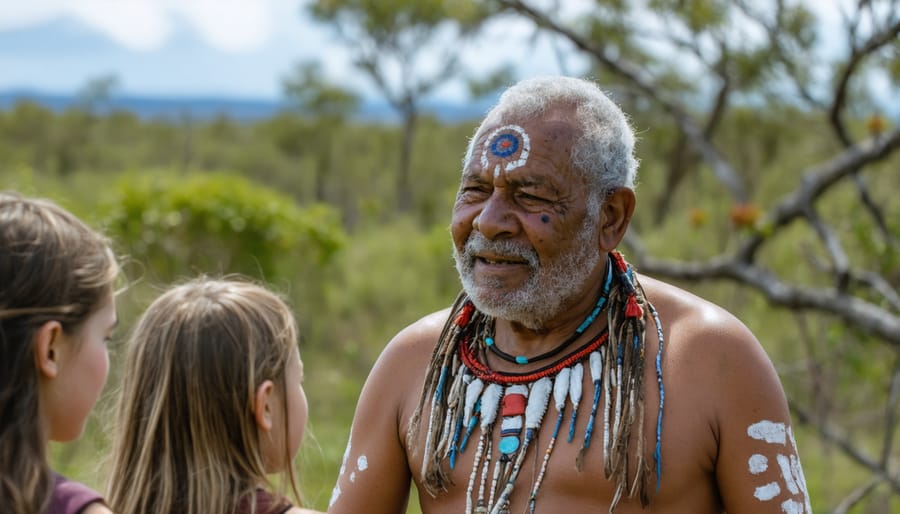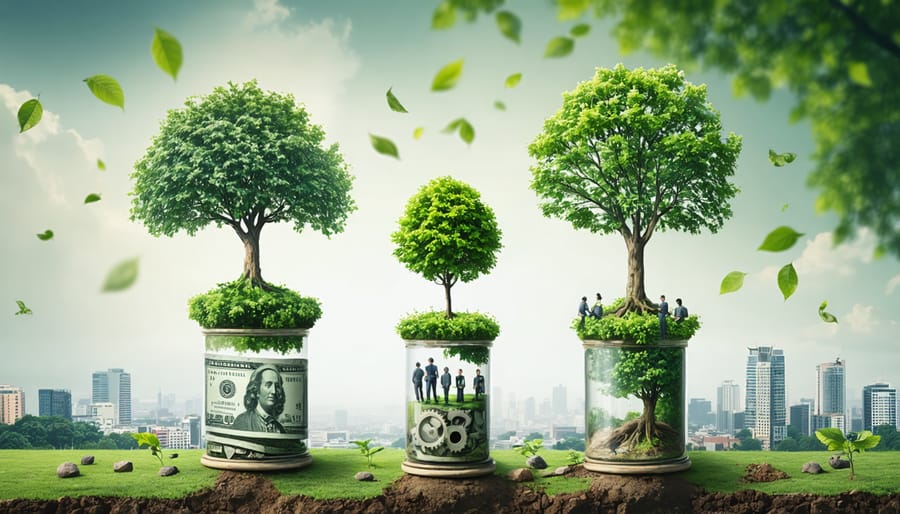Sustainability stands at the crossroads of our planet’s future, demanding immediate action and profound understanding. The foundations of sustainability rest on three interconnected pillars: environmental stewardship, social equity, and economic viability – a framework that has evolved from simple conservation to a complex science of planetary survival.
In Australia, where ancient Indigenous wisdom meets modern environmental challenges, we’ve learned that true sustainability requires more than just reducing carbon footprints or recycling plastics. It demands a fundamental shift in how we think about our relationship with the natural world, our communities, and our economic systems.
As we face unprecedented environmental challenges, from climate change to biodiversity loss, understanding these foundations becomes not just an academic exercise but a survival imperative. These principles guide everything from corporate boardroom decisions to community garden initiatives, showing us how individual actions connect to global outcomes.
The power of sustainability lies in its practical application – transforming theoretical knowledge into tangible solutions that benefit both people and planet. Whether it’s designing energy-efficient buildings, implementing circular economy practices, or developing regenerative agriculture techniques, these foundations provide the blueprint for creating a future that works for all.

The Three Pillars of Sustainability Education
Environmental Literacy
Environmental literacy forms the bedrock of sustainable practices, requiring a deep understanding of how natural systems interact and respond to human activities. Modern environmental curricula emphasize the interconnectedness of ecosystems, climate patterns, and energy cycles. This knowledge helps us recognize how our actions impact the environment, from local biodiversity to global climate systems. Understanding these fundamentals enables better decision-making about resource use and conservation efforts, particularly in Australia’s unique ecological context. By grasping these concepts, individuals and organizations can more effectively contribute to sustainability initiatives and develop innovative solutions for environmental challenges. This literacy empowers communities to make informed choices about energy consumption, waste management, and ecosystem preservation while fostering a deeper appreciation for our natural heritage.
Social Responsibility
Social responsibility in sustainability extends beyond individual actions to embrace community engagement and intergenerational equity. By fostering connections between generations, we create pathways for sharing traditional knowledge and innovative solutions. Australian communities showcase this brilliantly through initiatives like school garden programs and Indigenous land management practices, where elders work alongside youth to protect our natural heritage.
Teaching sustainability through a social lens helps students understand their role as stewards of the environment. This approach emphasises that today’s decisions impact future generations’ ability to meet their needs. Through community projects, students learn to consider long-term consequences of environmental choices and develop empathy for both present and future stakeholders.
Success stories from local councils and community groups demonstrate how collective action creates lasting change. When we embrace our social responsibility, we build resilient communities capable of facing environmental challenges together.
Economic Sustainability
Economic sustainability centers on creating long-term value while responsibly managing resources for future generations. Australian businesses are increasingly adopting circular economy principles, where waste becomes a resource and products are designed for reuse and recycling. Successful examples include innovative renewable energy projects in South Australia and sustainable agriculture practices in Victoria, demonstrating that profitability and environmental stewardship can go hand in hand.
Companies are finding that sustainable practices not only reduce operational costs but also attract environmentally conscious consumers and investors. From implementing energy-efficient technologies to developing eco-friendly supply chains, organizations are discovering that sustainability drives innovation and creates competitive advantages. This shift towards sustainable business models is creating new job opportunities in green industries while ensuring economic growth doesn’t come at the expense of our planet’s resources.
Practical Teaching Strategies
Experiential Learning Activities
Hands-on learning experiences form the cornerstone of sustainable education, providing students with practical knowledge they can apply in real-world situations. Through initiatives like the Eco Champions Program, learners engage in meaningful projects that demonstrate sustainability principles in action.
Popular activities include creating school gardens that teach food sustainability while providing fresh produce for the community. Students learn composting techniques, water conservation methods, and natural pest management strategies. Campus energy audits offer another practical learning opportunity, where participants analyse their institution’s energy usage and develop recommendations for reducing consumption.
Waste management projects encourage students to track and reduce waste through recycling programs and zero-waste challenges. These initiatives often lead to school-wide policy changes and measurable reductions in landfill contributions. Water quality monitoring programs connect students with local waterways, teaching them about ecosystem health while collecting valuable environmental data.
Community partnerships play a vital role in experiential learning. Students collaborate with local businesses to develop sustainable solutions, from designing eco-friendly packaging to implementing energy-efficient systems. These real-world projects not only reinforce theoretical concepts but also demonstrate the practical benefits of sustainable practices.
Documentation and reflection are essential components of these activities. Students maintain sustainability journals, create video documentaries, or develop presentations to share their findings with the broader community. This approach helps solidify learning outcomes while inspiring others to embrace sustainable practices in their daily lives.

Digital Resources and Tools
In today’s digital age, numerous online platforms and interactive teaching tools make sustainability education more engaging and accessible than ever before. The Australian Sustainability Education Hub offers comprehensive digital resources, including virtual field trips to renewable energy facilities and interactive carbon footprint calculators tailored to local contexts.
For hands-on learning, the Green Steps Digital Platform provides downloadable worksheets, lesson plans, and assessment tools that educators can easily integrate into their curriculum. The platform’s gamified elements help students understand complex sustainability concepts through practical, real-world scenarios.
Several mobile apps have emerged as valuable educational resources. The Sustainable Australia app tracks local initiatives and provides real-time data on community environmental projects. Meanwhile, the EcoChallenge platform encourages users to participate in daily sustainable actions while measuring their collective impact.
For data visualization, tools like the Australian Sustainability Dashboard offer interactive graphs and charts that make environmental metrics more understandable. These resources help learners track progress towards sustainability goals and understand the impact of their actions.
Social media platforms also play a crucial role, with dedicated channels sharing daily tips, success stories, and updates on sustainability initiatives. The #SustainableOz hashtag connects learners with a broader community of environmental advocates and experts across Australia.
These digital resources not only facilitate learning but also promote active engagement in sustainability practices, making it easier for individuals and organizations to implement positive environmental changes in their daily operations.
Integrating Australian Context
Local Environmental Challenges
Australia faces unique environmental challenges that demand innovative sustainability solutions. Our vast continent experiences regular droughts, bushfires, and coastal erosion, while urban areas grapple with air quality concerns and waste management issues. The Great Barrier Reef’s health remains a critical concern, affected by rising ocean temperatures and water quality degradation.
Water scarcity presents a persistent challenge, particularly in inland regions where agricultural communities depend heavily on reliable water sources. Urban centres face increasing pressure on infrastructure as populations grow, leading to challenges in sustainable urban planning and development. The loss of biodiversity in unique ecosystems like the Murray-Darling Basin and native bushland requires immediate attention and conservation efforts.
However, Australians are responding to these challenges with characteristic resourcefulness. Communities are embracing water-sensitive urban design, implementing innovative recycling programs, and developing drought-resistant farming techniques. Local councils are leading the way with green building initiatives, while indigenous knowledge is being increasingly integrated into land management practices.
Cities like Melbourne and Sydney are setting ambitious targets for renewable energy adoption and carbon neutrality. Coastal communities are developing resilience strategies for rising sea levels, while farmers are adopting regenerative agriculture practices to combat soil degradation. These local responses demonstrate how understanding specific regional challenges is crucial for developing effective sustainability solutions.
Indigenous Knowledge Systems
Indigenous knowledge systems represent one of the oldest and most valuable foundations of sustainability, offering profound insights developed over thousands of generations. Australian Aboriginal and Torres Strait Islander peoples have maintained sophisticated ecological practices that demonstrate deep understanding of environmental stewardship and sustainable resource management.
These traditional knowledge systems emphasize the interconnectedness of all living things and teach us about maintaining balanced relationships with the natural world. For example, Aboriginal fire management practices, known as cultural burning, have proven instrumental in preventing catastrophic bushfires while promoting biodiversity and ecosystem health.
Indigenous communities have developed precise understanding of seasonal changes, weather patterns, and wildlife behavior, creating sustainable hunting and gathering practices that ensure resource preservation. Their holistic approach to land management includes protecting sacred sites, maintaining food and medicinal plants, and preserving water sources through careful stewardship.
Modern sustainability efforts increasingly recognize the value of incorporating these time-tested practices. The success of joint management programs in national parks, where traditional knowledge combines with contemporary conservation methods, demonstrates the practical benefits of this approach. By learning from Indigenous wisdom, we can develop more effective and culturally appropriate solutions to current environmental challenges.
This integration of traditional ecological knowledge with modern sustainability practices creates a more comprehensive and resilient approach to environmental stewardship, one that honors both ancient wisdom and contemporary science.

Assessment and Evaluation
Progress Tracking Tools
Tracking progress in sustainability understanding is essential for meaningful growth and implementation. Australia has developed several innovative tools that make this process both engaging and effective. The Sustainability Assessment Matrix (SAM) has become a standout favourite among educators and organizations, offering a clear framework to measure comprehension and practical application of sustainability principles.
For individuals and organizations just starting their sustainability journey, the Traffic Light Assessment tool provides an intuitive way to evaluate progress. Using familiar green, amber, and red indicators, it helps track understanding across key sustainability domains: environmental stewardship, social responsibility, and economic viability.
Digital platforms have revolutionized progress tracking, with many Australian institutions adopting interactive dashboards that provide real-time feedback. These tools allow users to set benchmarks, monitor improvements, and identify areas needing additional focus.
The SMART Sustainability Rubric (Specific, Measurable, Achievable, Relevant, Time-bound) has proven particularly effective in educational settings. It breaks down complex sustainability concepts into manageable, measurable components, making it easier to track progress and celebrate achievements along the way.
Many organizations are now implementing sustainability scorecards that combine quantitative metrics with qualitative assessments. These comprehensive tools help create a more nuanced understanding of sustainability progress, ensuring that both theoretical knowledge and practical application are properly evaluated.
Student Engagement Indicators
Understanding how well students grasp sustainability concepts is crucial for effective education. Several key indicators help measure student engagement and comprehension in sustainability learning. Active participation in class discussions and projects serves as an immediate gauge of interest, while the quality of student-led initiatives demonstrates deeper understanding and commitment.
Look for students who make real-world connections between sustainability principles and their daily lives. When students start bringing up sustainability topics unprompted or suggest eco-friendly improvements for their school or community, it shows they’re internalising the concepts. Digital portfolios and project documentation can track progress over time, allowing educators to assess both individual growth and collective impact.
Successful engagement often manifests through collaborative projects, where students work together to solve local sustainability challenges. Watch for increased environmental awareness in simple actions, like proper waste sorting or water conservation. Student surveys and reflection journals provide valuable insights into their evolving attitudes towards sustainability.
Consider implementing a points-based system that rewards sustainable behaviours and innovative thinking. This approach not only motivates students but also provides measurable data on engagement levels. Regular assessments should focus on practical application rather than just theoretical knowledge, encouraging students to think critically about sustainable solutions in their unique Australian context.
The journey toward a sustainable future begins in our classrooms, where educators play a pivotal role in shaping the environmental stewards of tomorrow. Throughout this exploration of sustainability foundations, we’ve seen how interconnected systems thinking, ecological literacy, and practical implementation strategies form the bedrock of effective sustainability education.
As we’ve discovered, successful sustainability education goes beyond theoretical knowledge to embrace hands-on learning experiences and real-world applications. From establishing school gardens to implementing waste reduction programs, these practical initiatives demonstrate the power of action-based learning in creating lasting change.
The Australian context offers unique opportunities for educators to connect students with Indigenous knowledge systems and local environmental challenges. By incorporating these perspectives, we create more meaningful and culturally relevant learning experiences that resonate with our communities.
Moving forward, we encourage educators to take bold steps in implementing these foundations in their teaching practice. Start small, but think big. Create collaborative networks with fellow educators, engage with local environmental groups, and celebrate every success along the way. Remember, each lesson taught about sustainability plants a seed for future environmental consciousness.
Let’s embrace our role as sustainability champions and equip the next generation with the knowledge, skills, and passion they need to create a more sustainable world. Together, we can turn these foundations into transformative action that benefits both people and planet.

